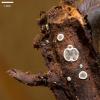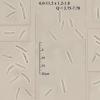
02-01-2026 17:43
MARICEL PATINOHi there, although I couldn't see the fruitbody, I

04-01-2026 17:45
 Stephen Martin Mifsud
Stephen Martin Mifsud
I was happy to find these orange asmocyetes which

03-01-2026 13:08
Niek SchrierHi all,We found groups of perithecia on a Lecanora

29-12-2025 17:44
Isabelle CharissouBonjour,J'aimerais savoir si d'autres personnes au

01-01-2026 18:35
Original loamy soil aside a artificial lake.The co

31-12-2025 19:27
Collected from loamy soil, at waterside (completel
Dear friends
This Mollisia makes small greyish fruitbodys on rhizomes of Juncus balticus at 1800 m of altitude.
Asci up to 40 x 5, IKI b, with croziers, 8-spored. Ascomata KOH negative. The ascospores I think are narrower of those of Mollisia palustris.
Have you some idea?
Thanks
I wonder if this has some relation to Mollisia chionea? The ascospores would be of comparable thickness, but are at the shorter lengths of your collection. It has been reported on Juncus in the UK several times and is (I think) a possible tentative match.
http://biodiversitylibrary.org/page/8967530#page/172/mode/1up
http://biodiversitylibrary.org/page/8967530#page/162/mode/1up (figures 21-24)
Discorehmia eburnea is a synonym of Mollisia chionea (according to Index Fungorum), and is described with ascospores 7-8 x 1.5 um, which would be more in line with your collection.
But there's always the possibility that these two species could be misclassified in Mollisia - I haven't looked into the matter very far!
Either way, I think your species is probably a close relative of one of the Mollisia palustris look-alikes, but not conspecific.
Cheers,
Brian
Hi Brian
Perhaps is a possibility, although the whitish/translucent colour of the ascomata of M. chionea and the shorther ascospores are different.
I think so. This fungus is very close related with M. palustris but is not the same species.
Many thanks for help me





